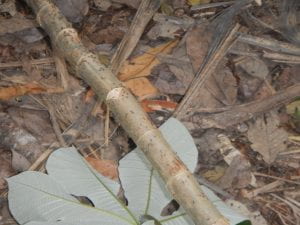May 19th, 2019
My day started off with the usual, morning birding the grey Plumbious kite was in its usual spot and the Social Flycatchers were chirping about. A lone Scarlet Macaw flew into view and started to preen itself, all I could see was it’s a large silhouette with its trademark long tail feathers. We also saw a Keel-billed Toucan today, with its blackbody, oversized green beak, and its yellow throat. After birding and some much-needed breakfast, we set off on a busy day.
First, we investigated how hurricanes affected the biodiversity in the Chiqibul forests. We used the point intersect method, which is picking a specific length of trail, and a length off trail and counting and categorizing plant species that touch the tape measure. We did this in a hurricane damaged area (disturbed) and an undisturbed area. What we found was that the species composition of the areas were very different but the biodiversity levels were very similar. However, as a whole, disturbed areas add more biodiversity to the forest due to allowing different species to flourish. After presenting our findings and eating lunch, we went off on a trail to find sapodilla trees. These trees have a symbiotic relationship with ants where they provide shelter and food while the ants provided detection. However, it does take some time for the ants to colonize so the sapodilla may use leaf toughness to ward off herbivores (making leaves hard to make a hole into). We measured the grams of force needed to puncture a whole into 11 uncolonized trees and 11 colonized trees, data that we will be analyzing tomorrow. The ants came flooding out of the colonized trees and packed a small but very painful bite.

We then went on a hike to the bird tower, a metal and wood tower that is on a 400-foot-high hill. The view from up there was absolutely amazing, you could see the research station and the surrounding forest. You could even see the Mayan Mountains in the background. We walked back in the dark and I spotted a Jumping Pit Viper and a grey rat. Yes, rats are mammals as are all rodents. Rodents actually make up a large part of Mammalia and are found on all continents except for Antarctica.
We ended the day with dinner and presentation on reptiles, beetles, and: tropical diseases, parasites, and medicines.

